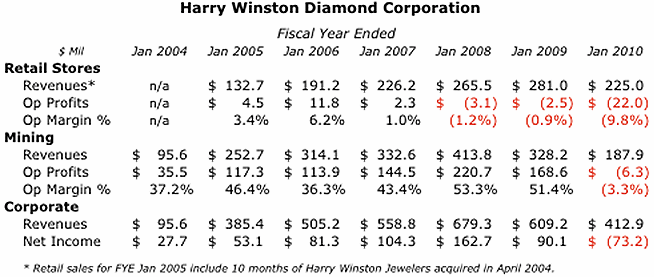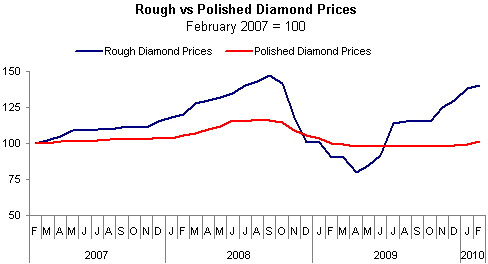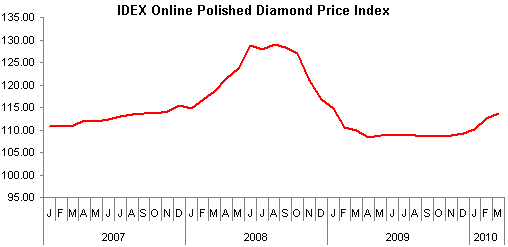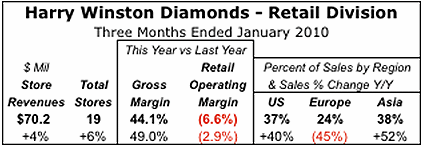IDEX Online Research: Harry Winston Prospects Improve
April 08, 10
Harry Winston’s chairman Bob Gannicott characterized 2009 as “Annus Horribilis” in a recent investor presentation. It is no wonder: for the full year, total corporate revenues were down 32 percent, with mining sales down a dramatic 43 percent and retail sales down 20 percent. It was the first unprofitable year since the company began producing diamonds back in late 2003.
The table below summarizes revenues and profits for the company since it began producing rough diamonds.

Source: Company reports
Fourth Fiscal Quarter Ended January 2010 Shows Rebound
However, for the fourth fiscal quarter ended January 2010, there was good news: mining revenues bounced back by 24 percent over the same three-month period a year ago and Harry Winston retail sales rose by a modest 4 percent, the first quarterly gain in a year. Despite the good news about revenues, overall corporate profits remained elusive. While the mining segment was modestly profitable in the fourth quarter, those profits were offset by a large loss in the retail segment.
Investor Presentation Highlights Rough Diamond Prices vs Polished Diamond Prices
In his year-end financial presentation to investors, Gannicott noted that rough diamond prices have been far more volatile than polished diamond prices during the recessionary period of 2007-2009. This trend has been confirmed across the industry among all diamond producers.
Gannicott went on to say that there was a “myth” about the gap between rough diamond prices and polished diamond prices in the post-recession period of late 2009 and early 2010. Further, he said, “polished diamond prices have essentially recovered,” similar to rough diamond prices.
Unfortunately, the facts don’t confirm this statement.
Rough Diamond Prices Bounce Back to Pre-Recession Peak Levels, But Polished Prices Continue to Languish At Pre-Recession Lows
The graph below compares rough diamond price movement, based on Harry Winston’s data, to polished diamond prices based on the IDEX Online Global Polished Price Index. Harry Winston’s price data was indexed to 100 as of February 2007; we have indexed IDEX Online’s price data to 100 as of the same date for the sake of comparison.

Source: Company reports & IDEX Online
As the graph clearly shows, rough diamond prices rose more than polished diamond prices in 2008, but when the bubble burst in the August-September 2008 period, rough prices plunged dramatically while polished prices fell much more modestly. Clearly, rough diamond prices have been volatile.
Here’s what’s important: since their low early in the second quarter of 2009, rough diamond prices have recovered to nearly their peak levels (blue line on the graph).
In contrast, polished diamond prices rose sharply until the bubble burst in late August 2008, and prices fell. However, it is clear from the graph that polished prices remain depressed (red line) and have not recovered to their pre-recession high.
Based on an index of 100 as of February 2007, rough diamond prices are now at an index of about 140, just below the August 2008 peak of about 145.
In dramatic contrast, the polished diamond price index is just under 102, or roughly at the same level as February 2007.
In short, between February 2007 and February 2010, polished prices have shown virtually no net increase - the sharp rise in 2008 was offset by the decline in early 2009 - while rough diamond prices are up 40 percent in the same three-year period. That’s a huge gap by any definition.
Polished Diamond Prices Remain at Pre-Recession Low Levels
The graph below summarizes global polished diamond prices based on the IDEX Online Global Polished Diamond Price Index with 100 = July 2004.
Using the IDEX Online polished diamond price data, it is clear that average polished diamond prices today are at about the same low level as in early 2007, and have not recovered to anywhere near peak levels seen in August 2008, just prior to the bursting of the price bubble.
We note, though, that there has been some modest increase in polished diamond prices during the past four months. This is in stark contrast to rough prices which have increased dramatically and are back to nearly peak levels.

Source: IDEX Online
Fourth Quarter and Year-End Highlights
Other highlights from Harry Winston Diamonds’ fourth quarter and year-end financial results include the following:
Rough Diamond Business
· Harry Winston’s management noted that rough diamond prices began a steep decline following the collapse of Lehman Brothers in September 2008. The slide in prices did not end until March (or April) 2009, at which time rough diamond prices were about half of their pre-recession highs.
· Prices of rough diamonds have now rebounded to near the previous highs as demand has strengthened in emerging economies led by China and India. Gannicott said that the rough diamond industry is broadly producing at (or near) capacity, and that significant production increases near term are not likely. Thus, current demand for diamonds from China and India, coupled with a rebound in diamond demand in the U.S. and Europe, implies that rough diamond prices will continue to rise.
· Prices of rough diamonds that produce polished diamonds in the four-to-eight carat range have not recovered to the prices achieved at the peak in August 2008. IDEX Online Research has seen a parallel in prices of polished stones in this size range: they have not recovered as rapidly as the prices of diamonds in the three-carat and under size range. Prices of other rough diamonds either have returned to their peak prices or now exceed prices at the August 2008 peak, according to Harry Winston’s Gannicott.
Harry Winston Retail Division
· The fourth quarter ended January 2010 was the first fiscal period during the year when Harry Winston retail sales exceeded the prior year’s retail sales. Revenues were up in all regions except Europe.
· Financial results, including sales by region (with year-to-year comparisons) for the fourth fiscal quarter, are shown on the following table:

Within regions, demand by Middle East and Russian customers for Harry Winston diamonds was weak in 2009, but demand now appears to have firmed earlier this year. Demand in Asia remains strong, with China leading the way. The company plans to expand its wholesale and retail distribution in Asia, with a focus on China.
· The positive momentum achieved at Harry Winston’s retail stores has continued through the first fiscal quarter of the new year. Asian markets have been strong, and sales in the U.S. and European markets are clearly on the rebound.
· The Harry Winston retail division has seen particularly strong demand for unique diamond jewelry as well as rare pieces and special orders. This is a trend that IDEX Online Research has noticed throughout all levels of jewelry retailing. Jewelry shoppers want “something different.”
· By price point, demand for Harry Winston jewelry has been particularly strong for unique pieces over $500,000 retail, including pieces selling for $1 million and up, as well as engagement jewelry in the $10,000 to $15,000 range.
· Harry Winston management also noted that its bridal jewelry demand was solid throughout the recessionary period, and remains strong today.
· Harry Winston’s retail gross margin fell in the fourth quarter to 44.1 percent from the prior year’s 49.0 percent due to a higher mix of timepieces and very high-end jewelry, both of which carry below-average margins.